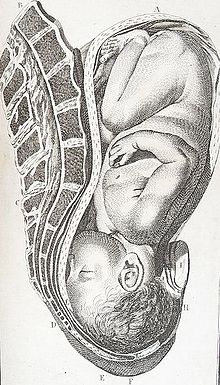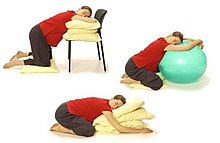Ime ímé na azụ


Ọrụ azụ (nke a na-akpọkarị ọrụ azụ) bụ okwu na-ezo aka na mmetụta nke ihe mgbu ma ọ bụ ahụ erughị ala nke na-eme na azụ ala, n'elu Ọkpụkpụ azụ, na nne n'oge ịmụ nwa.[1][2][3]
Enwere ike ịhụ ime ímé azụ mgbe nwa ahụ chere ihu n'elu n'ọwara ọmụmụ (occiput postlrior), ọ bụghị ihu n'ala, nke mere na a na-akwagharị azụ nke okpokoro isi nwa ahụ (occipot) megide sacrum nne. Otú ọ dị, ịme ime n'azụ nwekwara ike ime mgbe nwa ahụ nọ n'ọnọdụ dị iche. [3]A na-ahụkarị na ahụ erughị ala na-egbu mgbu nke ukwuu, ọ pụkwara ghara ịda mbà kpamkpam n'etiti mkpi. [4]Enweghị ike ịkọ ta ma ọ bụrụ na ọ ga-eme n'azụ. Akụkọ banyere ole nne na-arụ ọrụ azụ dịgasị iche, ọ bụ ezie na atụmatụ dị n'agbata pasenti iri ato bụ ihe a na-ahụkarị.[5][6][7]
Omume ndị a tụrụ aro iji meziwanye ímé ímé n'azụ gụnyere mmega ahụ, ịgbanwe ọnọdụ, ịsacha azụ, ịhịa aka mmiri, itinye ọkụ ma ọ bụ oyi n'azụ ala, iji bọl ịmụ nwa na ọgwụ gụnyere epidural. [8][9][3][10]Nnyocha ụfọdụ atụwo aro na ịgbanye mmiri na-adịghị ọcha n'ime azụ ala nwere ike inye ohere mgbu, mana enweghị nkwekọrịta na ọ na-enyere aka n'ezie.[11]
Hụkwa
[dezie | dezie ebe o si]Ebemsi dee
[dezie | dezie ebe o si]- ↑ Moore, Mary Lou & Ora Strickland, Realities in Childbearing, p. 398 (1978) (using term "posterior labor")
- ↑ El Halta, Valerie Posterior Labor---A pain in the back! Templeeti:Webarchive, ICAN Clarion 1996; 2(1)
- ↑ 3.0 3.1 3.2 Harms, Rogert W. Does back labor really happen?, mayoclinic.com, Retrieved 8 September 2014
- ↑ Klossner, N. Jayne. Introductory Nursing, Vol. 1, pp. 190, 432-33 (2006)
- ↑ Lieberman, Adrienne B. Easing Labor Pain: The Complete Guide to a More Comfortable and Rewarding Birth, p. 17 (1992) (This 1992 book says childhood educators typically cite 25%)
- ↑ Curtis, Glade B. & Schuler, Judith. Your Pregnancy After 35: Revised Edition, p. 290 (2001)
- ↑ Melzack, R. & D. Schaffelberg. Low-back pain during labor, Am J. Obstet Gynecol., 1987 Apr; 156 (4):901-05 (abstract) (1987 finding that "continuous low-back pain is severe and is reported by about 33% of women during labor.")
- ↑ Simkin, P. The fetal occiput posterior position: state of the science and a new perspective, Birth 2010 Mar; 37(1)l 61-71
- ↑ (25 July 2013). Positions and comfort measures to easy back labor, allparenting.com
- ↑ Murkoff, Heidi & Sharon Mazel. What to Expect When You're Expecting, p. 367-368 (4th ed. 2008)
- ↑ Derry (2012). "Intracutaneous or subcutaneous sterile water injection compared with blinded controls for pain management in labour". Cochrane Database Syst Rev 1: CD009107. DOI:10.1002/14651858.CD009107.pub2. PMID 22258999.
